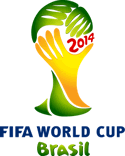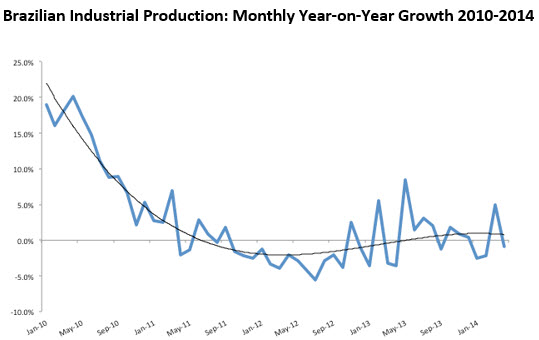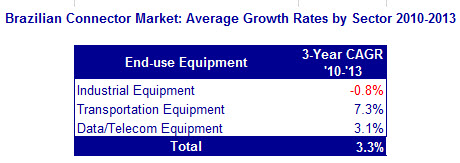Brazil: Impact of the World Cup on the Connector Market
As Brazil hosts the world’s greatest sporting competition this month and also prepares for the 2016 Summer Olympics, what will be the impact of the World Cup on the connector market?
Before we move on to the Brazilian connector market: What, if any, is the positive impact of the World Cup and upcoming Olympic Games (2016) on the Brazilian economy?
 This is a question that has triggered a lot of discussions among Brazilians, economists, politicians, and other stakeholders, and even resulted in large-scale street protests in Brazil itself. How do we measure the impact and how does it benefit the economy and people of Brazil? There is no easy answer to this. It is possible that eventually the total costs will be higher than the benefits warrant. There have been many global sports events in the past that cost the host countries huge sums of money. Apart from the bottom line result, it is clear that these events will trigger investments into specific markets, such as:
This is a question that has triggered a lot of discussions among Brazilians, economists, politicians, and other stakeholders, and even resulted in large-scale street protests in Brazil itself. How do we measure the impact and how does it benefit the economy and people of Brazil? There is no easy answer to this. It is possible that eventually the total costs will be higher than the benefits warrant. There have been many global sports events in the past that cost the host countries huge sums of money. Apart from the bottom line result, it is clear that these events will trigger investments into specific markets, such as:
- Engineering and construction: Building new/refurbishing existing stadiums and other infrastructure works to accommodate athletes and visitors (e.g. roads, rail, hotels, shopping centers, energy networks, water and waste plants)
- Telecom and media: Roll-out of (4G) data networks, Wi-Fi access, and IT infrastructure and building infrastructure to cover the matches and provide access to Internet and other communication networks for all visitors and residents
- Transportation: Provide sufficient transportation by air, land, and sea to handle the influx of visitors (rolling stock, airplanes, metro)
 In addition, the World Cup and the Olympics will boost tourism in Brazil. According to Brazil’s Ministry of Tourism, an estimated 3.7 million people are expected to travel throughout Brazil during the 2014 FIFA World Cup. During his or her stay in Brazil, the average foreign tourist will attend four World Cup matches and spend approximately $2,488. The economic windfall for Brazil based on the influx of visitors is estimated to add roughly $3.03 billion to Brazil’s economy.
In addition, the World Cup and the Olympics will boost tourism in Brazil. According to Brazil’s Ministry of Tourism, an estimated 3.7 million people are expected to travel throughout Brazil during the 2014 FIFA World Cup. During his or her stay in Brazil, the average foreign tourist will attend four World Cup matches and spend approximately $2,488. The economic windfall for Brazil based on the influx of visitors is estimated to add roughly $3.03 billion to Brazil’s economy.
Is it safe to say, therefore, that the World Cup and Olympic Games will have a positive influence on the connector market in Brazil? According to the latest research report by Bishop & Associates on the connector markets in emerging economies, which includes Brazil, the connector market in Brazil declined by 12.9% in 2012. Growth in 2013 was 3.8%, not much more than the growth of the global connector market in 2013 with 2.7%.

Brazil, the world’s sixth-largest economy, is a top exporter of farm products (sugar, coffee, oranges, beef, poultry, soy) and manufactured goods (from airplanes to vaccines), and it may join the ranks of the world’s biggest oil suppliers before long with Petrobras. Industrial production in Brazil in the period between 2010-2014, however, shows a steep drop in industrial production from 2010 onwards. In the next graph, the monthly industrial production is compared with the same month a year earlier. Industrial production growth slows dramatically from 2010 and becomes negative in 2012, and since has been rather “choppy” on a month-to-month basis.

It appears the Brazilian connector market only got a little boost, if any at all, from the preparation for the World Cup and (so far) the preparation for the Olympic Games in 2016. The telecom/datacom market sector, already the biggest sector for connectors in Brazil, may well have received some stimulus due to the investments in IT infrastructures and telecom networks. If we take a closer look at the performance of three key end-use equipment sectors that should have received the biggest stimulus from the World Cup and the Olympic Games, we see (next table) that together they show a 3.3% compound average growth rate for the past three-year period between 2010-2013. If we compare this to the CAGR of 0.8% for the total Brazilian connector market over the same period, this is indeed a higher growth rate and thus we could conclude – with some reservations – there may have indeed been a positive impact.

Combined, these three market sector represented 48.5% of the total Brazilian connector market. The remainder of the Brazilian market (51.5%) recorded a compound average growth rate of -1.4%, i.e. a decline of the market over the same three-year period.
Of course, it is not as simple as this to conclude anything regarding the impact of these large sports events on the Brazilian connector market. There are too many factors that influenced the performance of the Brazilian connector market during the past years from 2010-2013 to say anything conclusive. The recent slowdown in the recovery of the world economy combined with sentiments on international financial markets, currency effects, and other local or global issues have had and will have a larger impact on the Brazilian market than these isolated sports events on their own. The peak in 2010 may well have been partly the result of the large investments, starting in 2009, for these premier sports events. It should be noted, however, that in 2010 the global recovery triggered a growth spurt in the global connector market and not just in Brazil.
Bishop & Associates will continue to follow the performance of the Brazilian connector market. In the run-up to the 2016 Olympic Games, it will be interesting to see if we detect any rise in connector consumption. However, 80% (about $52 billion) of total investments planned between 2009-2016 for both events have already been made. Only another 20% (about $11 billion) will be spent for the Olympic Games during 2014-2016.
For now, let’s sit back, crack open a beer, and enjoy the World Cup…
Arthur Visser, VP, Bishop & Associates, Inc.
- The Industrial Market for Connectors in a Changing World - April 20, 2021
- How Key Trends in the Transportation Market Will Impact Electronics Growth - March 17, 2020
- Automation Means a Bright Forecast for Industrial Connectors - February 19, 2019



